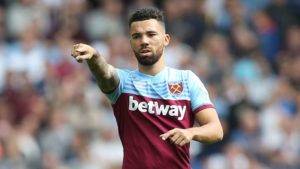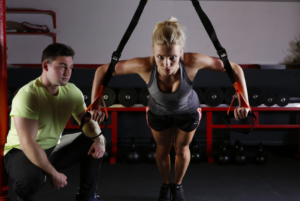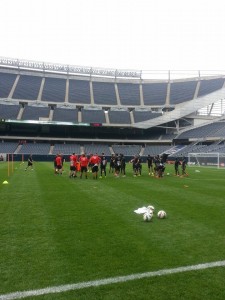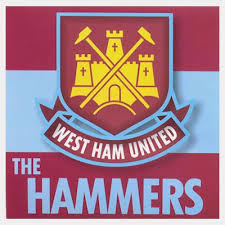It’s one thing to be healthy, and not hurt. It’s quite another to be full fitness, or “match fit.” Athletes in the Premier League know the distinction quite well.
“The difference is huge,” says West Ham United defender Ryan Fredericks. “You can spend as long as you want – years, even – running up and down the pitch or running around cones, but 10 minutes in a Premier League match is 100 times harder than any of that. “
“You can’t fake anything on a Premier League pitch. You have to react to so many things – mentally, as well. If you get caught out, you’re stuck.”
“Match fitness” is a long time buzz phrase in football, and we’re only going to hear it more as the Premiership makes its attempt at restarting in June, with players expected to be full go with much shorter preparation time than anyone would like.
The German Bundesliga has been long ahead of the curve, with some teams getting six weeks of training in before resuming play. Other leagues likely won’t have that luxury. Yet the term means different things across different sports, so what it truly means can be difficult to comprehend.
A lot of athletes have at home gyms with high-class equipment and access to trainers to keep them in good shape. Their base fitness levels, one would assume, should always be impeccable.
What Fredericks is referring to is the difference between being fit – injury-free – and actually being ready to play in a professional, competitive match.
“There are different aspects to it,” says Richard Collinge, Head of Medical Services at West Ham United.
“The science behind it all is now a major guide as to objectively clearing a player to return to training and then to return to a match, but the player has to also be psychologically ready.
“Those two things have to match, otherwise that player is not going to be ready to play.”
“I consider it a tripod of performance – physical, mental and emotional,” says Dan Garner, who has coached UFC champions Ronda Rousey and Michael Bisping, as well as three Super Bowl winners and an Olympic gold medallist, and is now head coach of the Hockey Training programme, based in Ontario.
“What happens if one leg of a tripod is knocked out? It collapses. In order to determine whether someone is actually ready, they would need to be mentally, emotionally and physically ready.”
The physical aspect is probably the easiest for fans to relate. Fitness targets, whether they be distances, weight lifted, calories burned etc. are something that many of us constantly grapple with.
“We have benchmarks and training data over several seasons so that we know what each player has got to achieve,” says Collinge.
“How fast he needs to sprint, the number of accelerations and decelerations he makes, the distance he covers.
“You also have to break that down into positional analysis. Match fitness is very different if you’re a goalkeeper from a modern-day wing-back.
“Using GPS data and distances covered, if a player has had a six-week hamstring injury we can tell what we need to prepare them for based on their position.”
“We do some change of direction testing, too, because they have to be able to pivot acutely. They have to be able to withstand the force of an opponent and strike a ball.”
“The rehabilitation period is not cleared until we can match as best as possible the loading of the tissue that will be required for full training and then a 90-minute match.”
Fredericks, who is precisely the type of explosive wing-back Collinge refers to, agrees that being ready to play in a game is far more complex than merely having the physical capacity to do so.
“The hard miles in games don’t really tire you out,” he says. “Sprinting up and down isn’t really what we find hard.
“The hard stuff is the short bursts of pace, when you’ve got to quickly get tight to someone. Nobody can tell you that you’re match fit unless you’ve been in the scenario where you’re having to struggle in the last 10 minutes and you’ve got to grind out a game.
“That’s when you find out about yourself, not doing runs in training.”
A player’s return to the reserve team is often heralded as a major milestone on the road back to match fitness.
In reality, this represents just one of the final hurdles to a first-team come back. They still have plenty to prove at this stage, not just in terms of their physical, but also mental well-being.
“When placed in front of spectators and a worldwide audience then the anxieties of the player come into play as well,” explains Collinge. “That can affect the tissue tone. It’s all interwoven. The player needs to feel comfortable that he can play a game.”
Fredericks agrees. “Match fitness comes from confidence,” he says.
“Going into the game knowing that you’re at a higher risk of injury or that you might blow up after 60 minutes isn’t ideal. You need to play two or three Under-23 games or training-ground games to get that. It’s unheard of to have a long time out and then go straight into the Premier League.”
The same applies to domestic matches in cricket.
“I use fitness baselines to determine whether a player is ready or not,” says Tumi Masekela, the strength and conditioning coach for the South Africa men’s cricket team.
“But if he’s at a good level then we will start him with our warm-up games or franchise games before we move back onto the international scene. That’s definite – we will not allow a player back to an international game without playing any games beforehand, so that we can evaluate their match fitness.”
But the same routines don’t work for all sportspeople.
Kevin Pietersen, who played 275 internationals and is England’s third-highest run-scorer of all time across all formats, felt that intense practise sessions were far more valuable for his match fitness than sanitised warm-up matches.
“I didn’t need to feel that match scenario,” says Pietersen. “I hated practise games, I hated trial games, I hated all that.
“I think if you calculated my average from all of the warm-up games that we played it would be terrible. I didn’t want to play in them, I had no interest in them, because they never made me feel like I felt when I practised.”
Instead, Pietersen would embark on a personal process that would enable him to be ready for every match in every series on every tour.
“Confidence is closely related to being match fit,” he says. “No player is free of niggles or little injuries, but I never ever went into an England match without being confident that I had put in the perfect preparation for it.”
“Perfection in my practise was the reason for my consistent performances.”
“I was always asking myself a series of questions: How do I feel in training? Have I got the ability to defend the best ball that a bowler could run into bowl at me when I walk out into middle? Or have I not? If so, where do I need to focus my attention?”
“I needed to know every single day that I played that I had done the most meticulous preparation so that when I crossed that white line I could execute the skill. I think I was one of a small group of people who thought about it like that.”
The nature of the cricket schedule means that players regularly have to adapt to new conditions in different parts of the world – not just in terms of pitches, but also climate.
That makes returning to match fitness an even more difficult process.
“It goes without saying that acclimatising to conditions is a big factor,” says Masekela. “If you’re going to play in different conditions, particularly when it’s hotter in the subcontinent, you need to give yourself enough time to adapt and perform at peak levels.
“That makes it even more difficult for the guys coming back from injury to hit their targets, but that’s why their baselines before injury are so important. If they’re trying to rush themselves, I can show them how far off the mark they are.
“You get some guys who are so passionate. They feel that if they’re not playing then they’re letting the team down.”
According to Garner, the emotional state of a player is the most important prong in recovering match fitness – not just after a return from an injury or a long break, but in preparing for matches on a regular basis.
“Athletes perform best when they enter what is known as a flow state,” he says.
“You don’t want to be too emotionally aroused, or you’ll start making bad decisions. You’re too jazzed up. But you also don’t want to be not aroused at all, because being too calm and too relaxed doesn’t have you hyped up enough.
“A flow state is right in the middle. That is 100 per cent emotionally-based.
“To be game-ready, an athlete needs to not have any injury limitations holding them back, but also has to focus on the mental and emotional components.”
Recognising that a player might be lacking the mental capacity to perform, Garner says, is “what separates the good coaches from the great ones”, and explains why coaches are so much more attuned to medical processes now than they might once have been.
At West Ham, for example, Collinge speaks daily with first-team manager David Moyes and his coaching staff to assess the fitness of players and set realistic targets for their returns.
“It’s all about clear dialogue,” says Collinge. “The process is one of joint decision-making.
“We might look at the frequency of games coming up and pencil in particular players for particular games. Then we discuss what that player needs to do to prove himself fit and available for that game.
“We as medical staff and coaching staff want the player to be confident, ultimately. We want to make sure that the psychology and feedback from the player is positive, so that they can feel primed for competitive action.”
The process is similar in the South Africa cricket team. Masekela decides which kind of baselines tests are required based on the profile of players that the coaches have told him they want.
“They might tell us that they need a robust guy, or something else, and based on that information we come up with the testing protocol,” he says.
“If the coach doesn’t agree with the kind of tests we do, or he doesn’t understand them, then they’re relying on my word only. I don’t want that to blow up in my face.”
His efforts are all focused on one end goal.
“If you have your guys firing on all cylinders you will produce a good game. That’s what we want: guys performing at 100 per cent and producing good entertainment.”
As professional sports being to commence restart, from an unscheduled hiatus, the challenge for fitness coaches all over the world is greater than ever.









